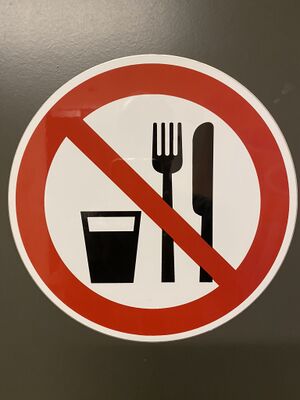Good Laboratory Practice (GLP)
Basic rules

- No internet on experimental PCs
- No food or drinks in the labs
- Make a reservation in QReserve
- Every experimenter keeps a personal lab journal.
- Never leave a subject alone
- There should be at least two people (apart from the subject) present in the lab when an experiment is run off hours †.
† Off hours = outside 9-17 hours or in the weekends or on holidays
Safety
- Follow safety protocols if available/applicable
- Never disable safety measures
- Never leave a subject alone
The vestibulair chair and the robot arm in particular are systems that can be really dangerous when not used properly.
Be a skeptic
Have a healthy skeptical and critical attitude towards everything.
- Earlier results from the literature and the lab could be messy! Interpretations could be wrong! Experimental designs could be flawed!, etc. etc.
- Opinions and ideas expressed by your supervisor could be (likely is) wrong!
- Be skeptical towards your own results. Ask yourself questions like:
What would I expect? There should be a ‘theory’, ‘model’.
What do I observe? Plot the data according to the expected theory, or model!
Do these coincide? If so, does it mean it’s okay? If not: what does it mean?
Is there something to worry about?
- Be skeptical of your own writing and data presentation style:
Read it out loud and wonder whether someone else would really understand what you’re saying….
Does the figure really tell what I intend to express?
- Last, but not least: never trust the experimental setup at face value!
Control measurements
- EVERY experimental protocol starts with STANDARDIZED control experiments.
- If a patient is going to be measured, this control experiment is run with a healthy subject BEFORE the patient is placed in the setup.
Real time data checking
In order to check data real time there should be a pre-cooked analysis and display (plot) that provides ALL the necessary data that are needed for a complete assessment of the data quality. This plot is stored on disk and belongs to the data set of that recording day.
Problem solving
Everybody should be aware that complex setups can ALWAYS break down. They break down when you LEAST expect it. You should be prepared to IDENTIFY such problems immediately. You CANNOT assume that if it worked yesterday, it will work today too!
Two short-term actions can be taken to prepare ourselves for this:
- EVERY experimental protocol starts with STANDARDIZED control experiments. The results of these controls are stored on disk with the actual data sets. These controls even get standardized names, so that they are readily identifiable.
- Experimental results and stimuli are analyzed and displayed ON THE FLY. Casual checking of signals from the Head Tracking System on the oscilloscope does not count as a real control (although it should be done too….).
Try to tackle the problem scientifically:
- Is it a technical (instrumentation) problem, or a physiological (subject) problem?
- If technical: inside the measurement cabin? (magnetic field, coil, speakers, LEDs) or outside (TDT, computer, amplifiers, …)?
- If you can’t find it (and did some basic tests): no shame, but warn the technicians.
- If a problem is not directly solvable:
A) Sent E-mail alert to other users.
B) Report the problem in the issue tracking system†.
†For issue tracking go directly to gitlab.science.ru.nl or visit the Issues Tracking page.